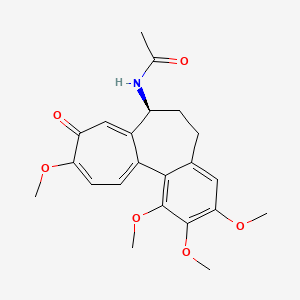Drug Information
Drug (ID: DG00124) and It's Reported Resistant Information
| Name |
Colchicine
|
||||
|---|---|---|---|---|---|
| Synonyms |
Colchicin; Colchicina; Colchicinum; Colchineos; Colchisol; Colchysat; Colcin; Colcrys; Colsaloid; Colstat; Condylon; Goutnil; Kolkicin; LOC; Binds to tubulin; Colchicin [German]; Colchicina [Italian]; Colchicine [JAN]; Inhibits microtubular assembly; Spindle poison; C 9754; Colchicine (TN); Colchicine, Colchicum autumnale; MPC-004; N-Acetyl trimethylcolchicinic acid methylether; Colchicine (JP15/USP); Colchicine, (R)-Isomer; Benzo(a)heptalen-9(5H)-one; Colchicine, (+-)-Isomer; N-(5,6,7,9-Tetrahydro-1,2,3,10-tetramethoxy-9-oxobenzo(a)heptalen-7-yl)acetamide; N-[(7S)-1,2,3,10-tetramethoxy-9-oxo-5,6,7,9-tetrahydrobenzo[a]heptalen-7-yl]acetamide; N-[(7S)-1,2,3,10-tetramethoxy-9-oxo-6,7-dihydro-5H-benzo[a]heptalen-7-yl]acetamide; N-[(7S)-5,6,7,9-tetrahydro-1,2,3,10-tetramethoxy-9-oxobenzo[a]heptalen-7-yl]acetamide; N-(5,6,7,9-Tetrahydro-1,2,3,10-tetramethoxy-9-oxobenzo[.alpha.]heptalen-7-yl)-acetamide; N-((7S)-5,6,7,9-tetrahydro-1,2,3,10-tetramethoxy-9-oxobenzo(a)heptalen-7-yl)-acetamide; (S)-N-(5,6,7,9-Tetrahydro-1,2,3,10-tetramethoxy-9-oxobenzo[a]heptalen-7-yl)acetamide; 7-alpha-H-Colchicine; 7.alpha.H-Colchicine; 7alphaH-Colchicine
Click to Show/Hide
|
||||
| Indication |
In total 1 Indication(s)
|
||||
| Structure |

|
||||
| Drug Resistance Disease(s) |
Disease(s) with Resistance Information Discovered by Cell Line Test for This Drug
(2 diseases)
[1]
[2]
|
||||
| Target | Tubulin (TUB) | NOUNIPROTAC | [1] | ||
| Click to Show/Hide the Molecular Information and External Link(s) of This Drug | |||||
| Formula |
C22H25NO6
|
||||
| IsoSMILES |
CC(=O)N[C@H]1CCC2=CC(=C(C(=C2C3=CC=C(C(=O)C=C13)OC)OC)OC)OC
|
||||
| InChI |
1S/C22H25NO6/c1-12(24)23-16-8-6-13-10-19(27-3)21(28-4)22(29-5)20(13)14-7-9-18(26-2)17(25)11-15(14)16/h7,9-11,16H,6,8H2,1-5H3,(H,23,24)/t16-/m0/s1
|
||||
| InChIKey |
IAKHMKGGTNLKSZ-INIZCTEOSA-N
|
||||
| PubChem CID | |||||
| ChEBI ID | |||||
| TTD Drug ID | |||||
| DrugBank ID | |||||
Type(s) of Resistant Mechanism of This Drug
Drug Resistance Data Categorized by Their Corresponding Diseases
ICD-02: Benign/in-situ/malignant neoplasm
| Drug Sensitivity Data Categorized by Their Corresponding Mechanisms | ||||
|
|
||||
| Key Molecule: ATP-binding cassette sub-family B5 (ABCB5) | [3] | |||
| Molecule Alteration | Expression | Down-regulation |
||
| Sensitive Disease | Colorectal carcinoma [ICD-11: 2B91.3] | |||
| Experimental Note | Revealed Based on the Cell Line Data | |||
| In Vitro Model | CaCo2 cells | Colon | Homo sapiens (Human) | CVCL_0025 |
| HCT-8 cells | Colon | Homo sapiens (Human) | CVCL_2478 | |
| NIH-G185 cells | Ovary | Homo sapiens (Human) | CVCL_L991 | |
| NIH 3T3 cells | Colon | Homo sapiens (Human) | CVCL_0594 | |
| Experiment for Molecule Alteration |
Western blotting analysis | |||
| Experiment for Drug Resistance |
MTT assay | |||
| Mechanism Description | G185 cells were 27-135 fold more resistant to the cytotoxic drugs doxorubicin, vinblastine, colchicine and paclitaxel than the parental NIH 3T3 cells. Co-administration of TPGS enhanced the cytotoxicity of doxorubicin, vinblastine, paclitaxel, and colchicine in the G185 cells to levels comparable to the parental. | |||
| Drug Resistance Data Categorized by Their Corresponding Mechanisms | ||||
|
|
||||
| Key Molecule: hsa-miR-106b~25 | [1] | |||
| Molecule Alteration | Expression | Up-regulation |
||
| Resistant Disease | Breast cancer [ICD-11: 2C60.3] | |||
| Experimental Note | Revealed Based on the Cell Line Data | |||
| Cell Pathway Regulation | Cell apoptosis | Inhibition | hsa04210 | |
| miR106b~25 cluster/EP300/E-cadherin signaling pathway | Regulation | hsa05206 | ||
| In Vitro Model | MTMECs cells | Breast | Homo sapiens (Human) | N.A. |
| Experiment for Molecule Alteration |
RT-PCR | |||
| Experiment for Drug Resistance |
Flow cytometry assay | |||
| Mechanism Description | miR-106b~25 cluster controls transporter-independent MDR by apoptosis evasion via downregulation of EP300. | |||
|
|
||||
| Key Molecule: Histone acetyltransferase p300 (EP300) | [1] | |||
| Molecule Alteration | Expression | Down-regulation |
||
| Resistant Disease | Breast cancer [ICD-11: 2C60.3] | |||
| Experimental Note | Revealed Based on the Cell Line Data | |||
| Cell Pathway Regulation | Cell apoptosis | Inhibition | hsa04210 | |
| miR106b~25 cluster/EP300/E-cadherin signaling pathway | Regulation | hsa05206 | ||
| In Vitro Model | MTMECs cells | Breast | Homo sapiens (Human) | N.A. |
| Experiment for Molecule Alteration |
Western blot analysis | |||
| Experiment for Drug Resistance |
Flow cytometry assay | |||
| Mechanism Description | miR-106b~25 cluster controls transporter-independent MDR by apoptosis evasion via downregulation of EP300. | |||
| Drug Resistance Data Categorized by Their Corresponding Mechanisms | ||||
|
|
||||
| Key Molecule: Multidrug resistance protein 1 (ABCB1) | [2] | |||
| Molecule Alteration | Expression | Up-regulation |
||
| Resistant Disease | Pituitary adenoma [ICD-11: 2F37.1] | |||
| Experimental Note | Revealed Based on the Cell Line Data | |||
| In Vitro Model | GH4C1 cells | Pituitary gland | Rattus norvegicus (Rat) | CVCL_0276 |
| Experiment for Molecule Alteration |
Immunocytochemical staining assay | |||
| Experiment for Drug Resistance |
Lowry assay; Bradford assay | |||
| Mechanism Description | Cells resistant to colchicine at 0.4 micrograms/ml, termed GH4C1/RC.4, exhibited the multidrug-resistance phenotype, as the LD50 values for colchicine, puromycin, actinomycin D, and doxorubicin were between 8 and 30 times greater than the corresponding values for the parental GH4C1 cells.Immunocytochemical staining with a monoclonal antibody, C219, to the 170-kilodalton P-glycoprotein showed directly that GH4C1/RC.4 cells overexpress P-glycoprotein. | |||
References
If you find any error in data or bug in web service, please kindly report it to Dr. Sun and Dr. Zhang.
